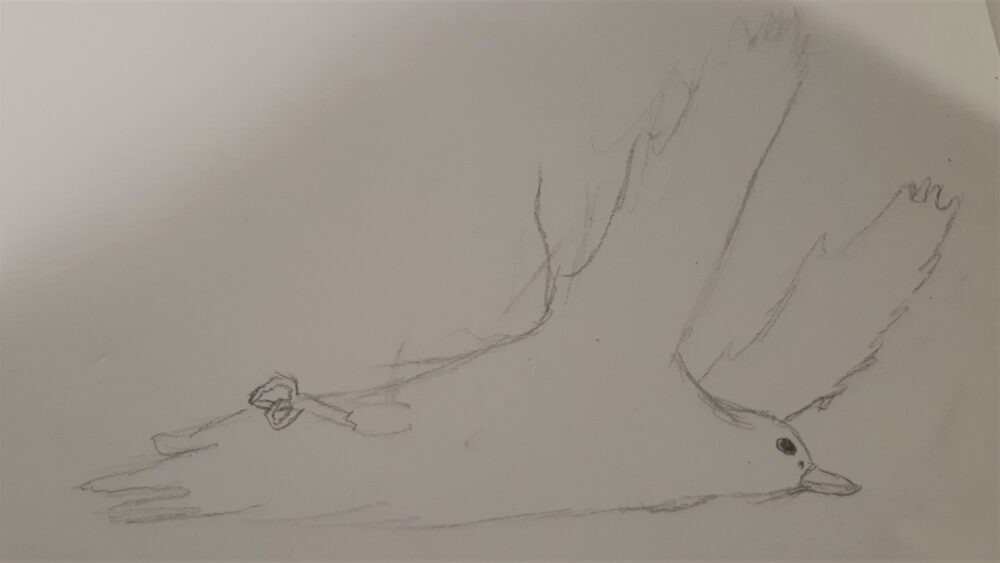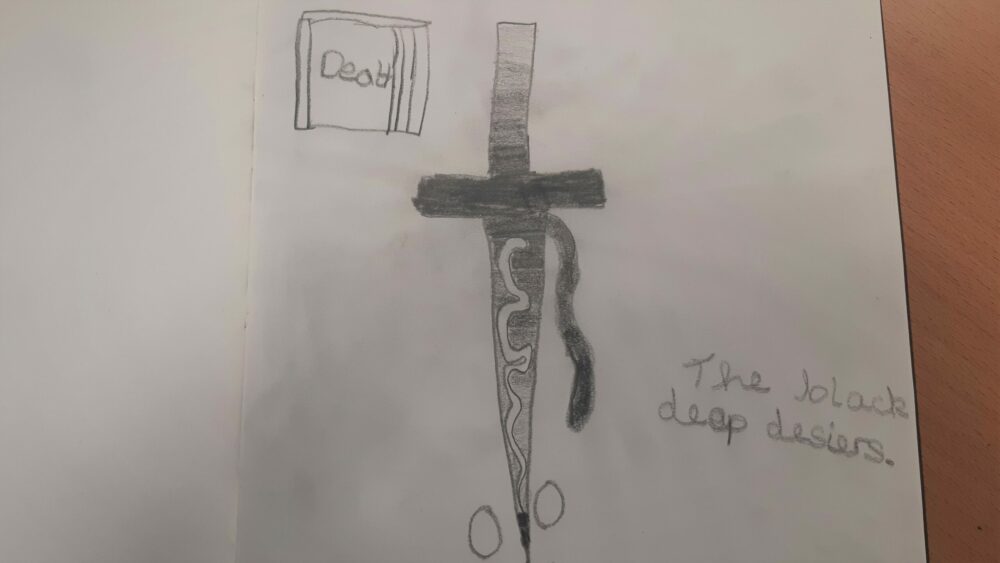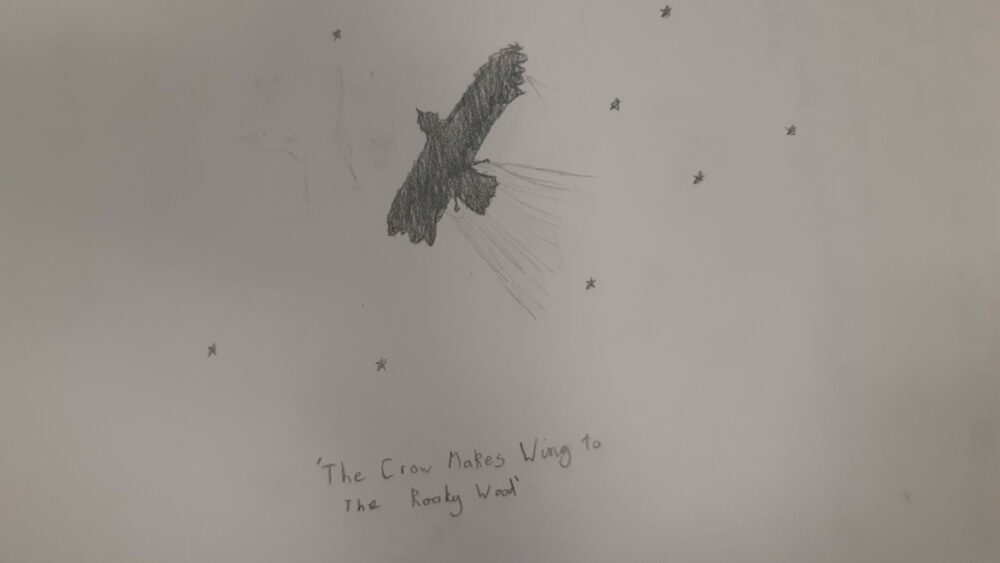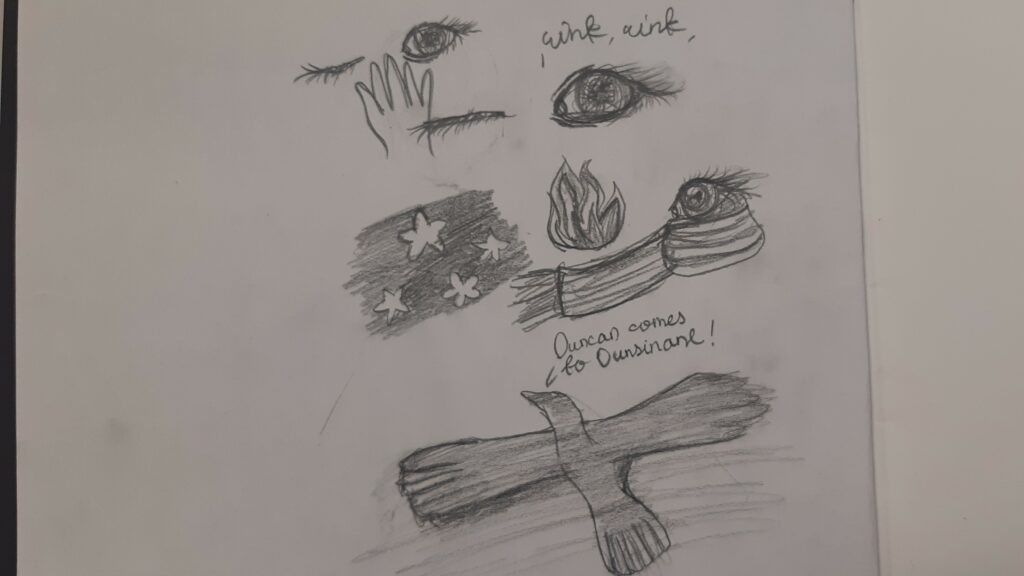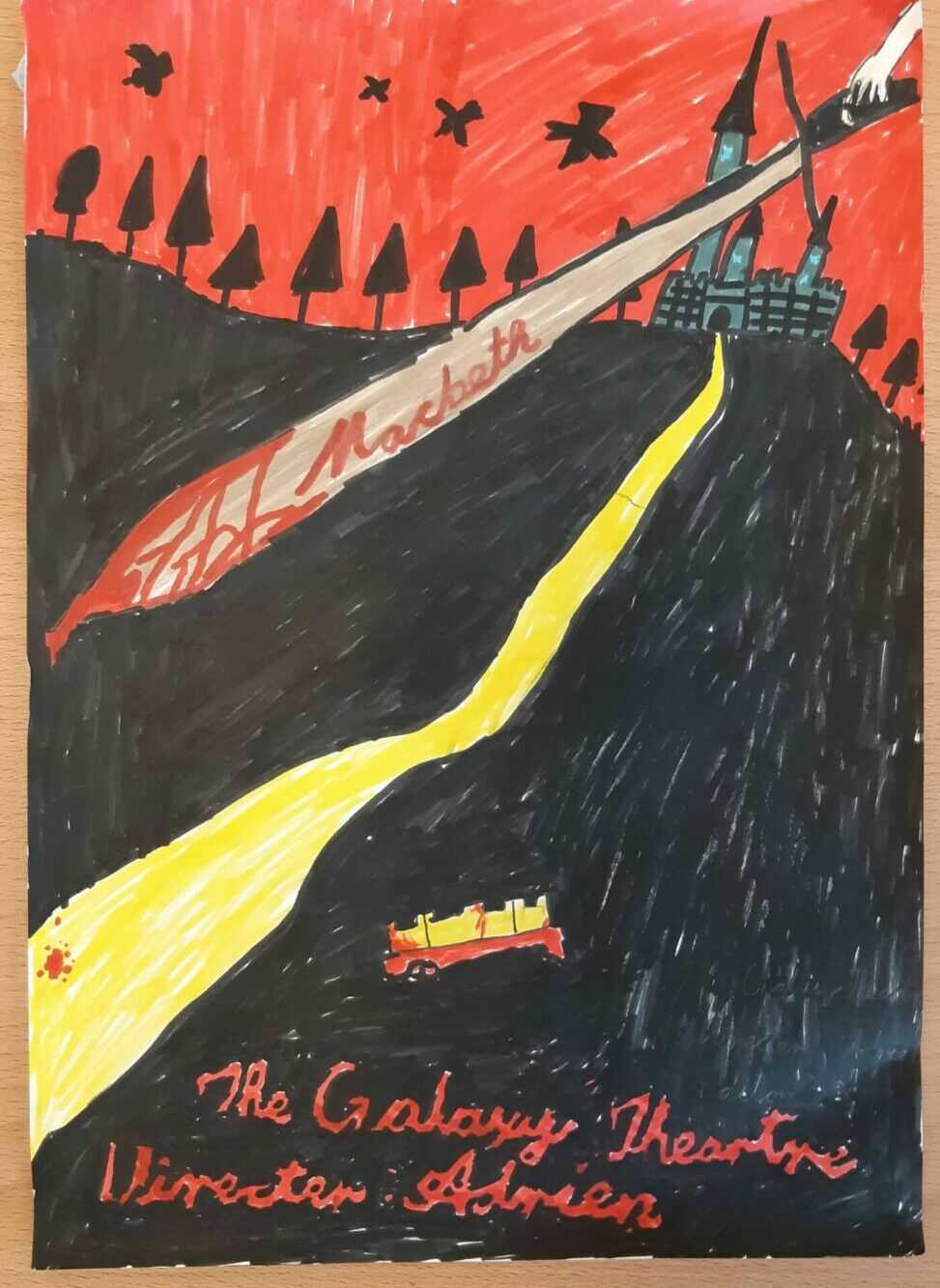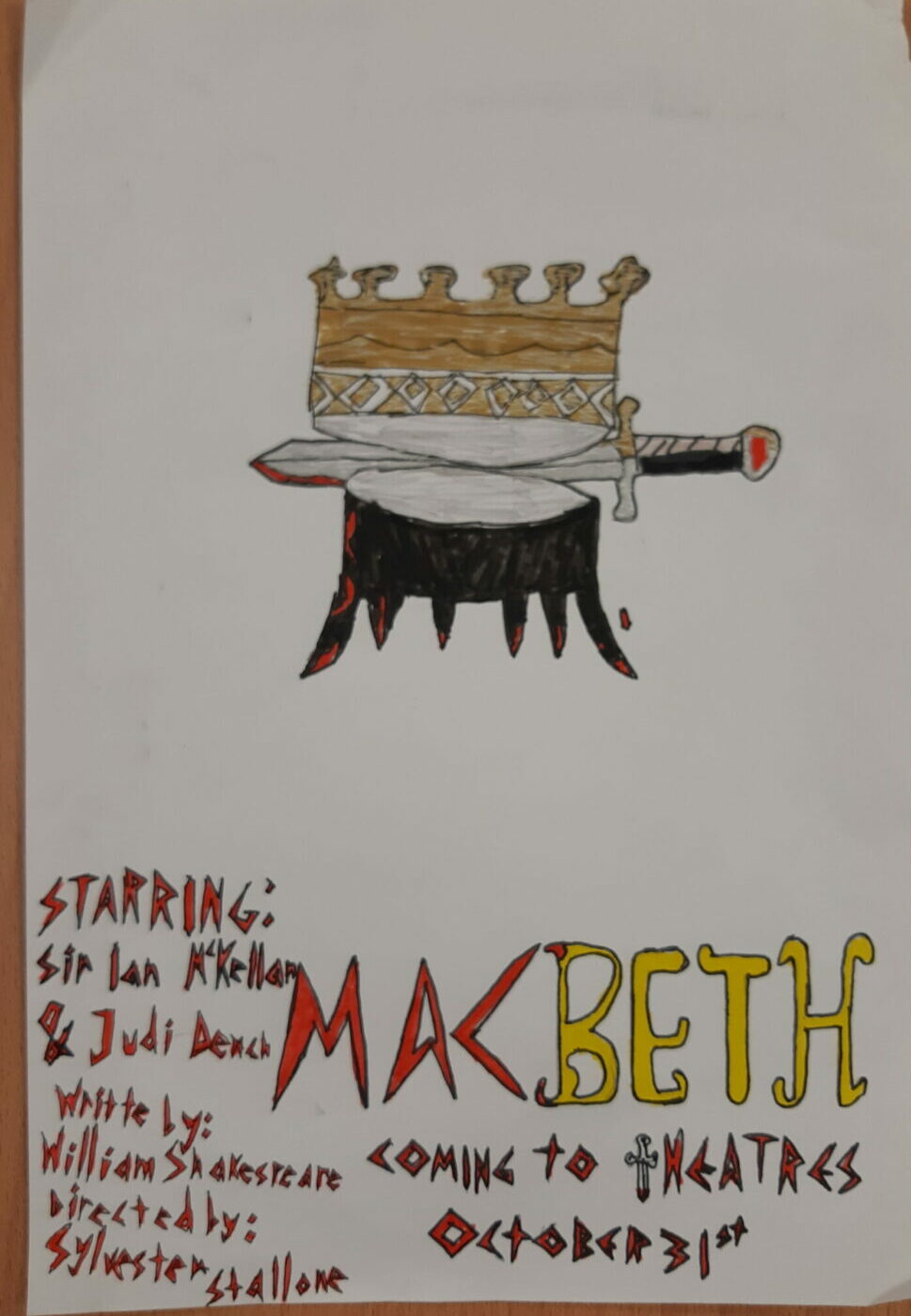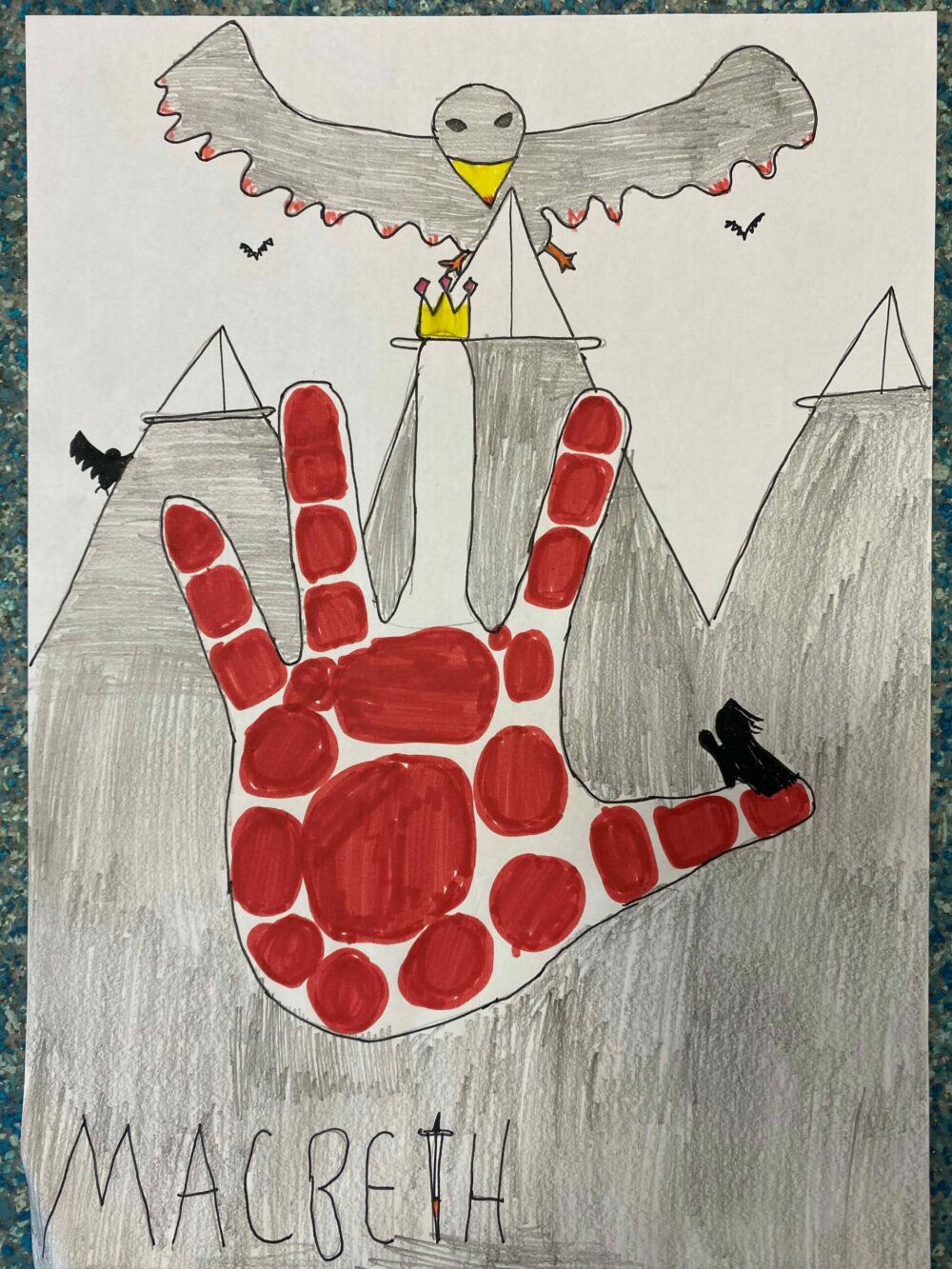Exploring Macbeth Through Art: Light and Dark Posters
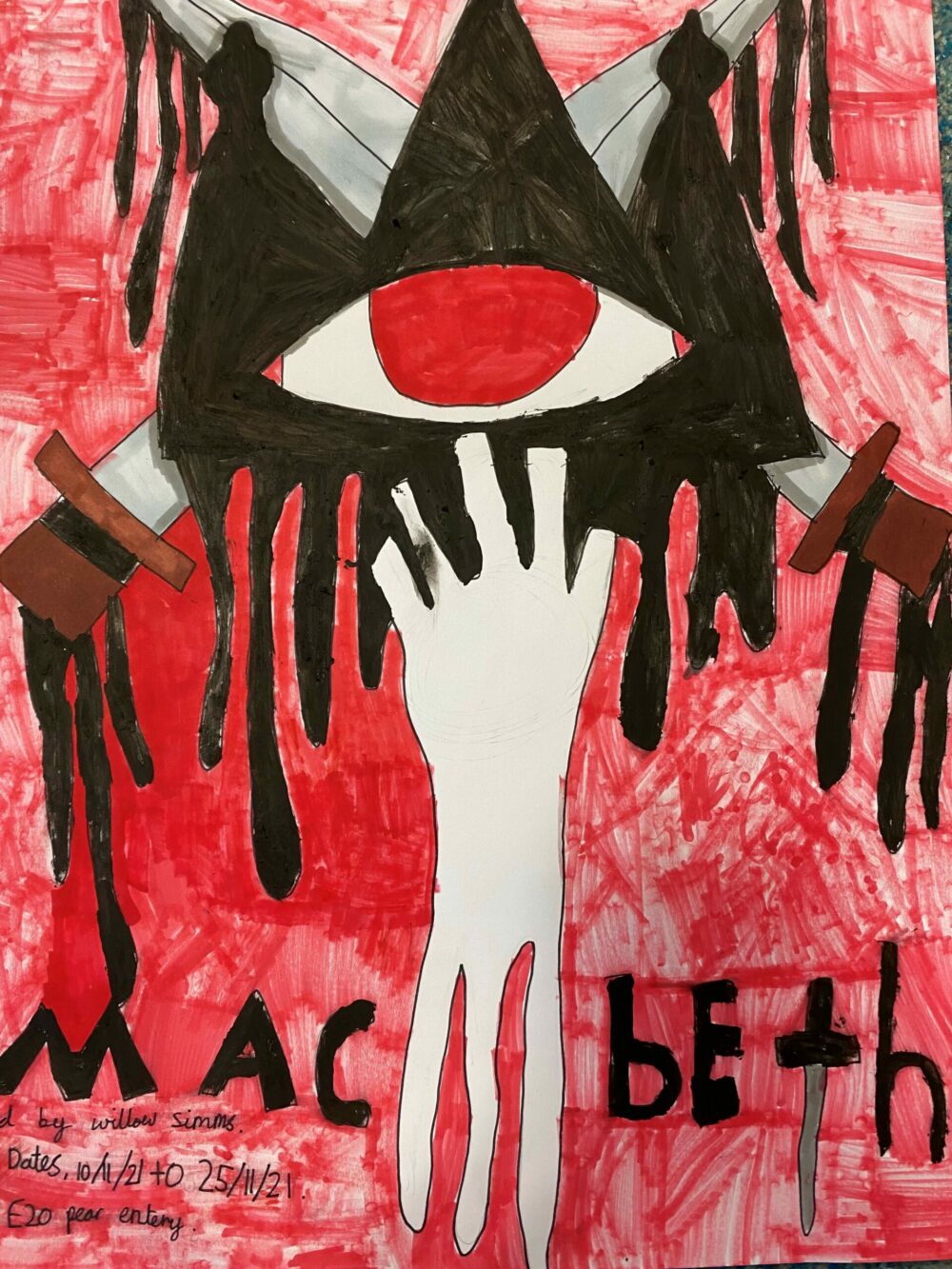
In this forth of six resources on Shakespeare’s Macbeth, children are invited to look closely at Macbeth and Lady Macbeth and role they play in the story. You can find the full resource collection here.
The aim of this session is to think carefully about the imagery and symbolism in Macbeth, and to draw representations of these before moving on to creating a poster that tells us about the play.
Back to all six sessions here.
Session 4: Light and Dark Posters
Warm up: 15 minutes
Main Activity: 45 Minutes
Materials Needed: Sketchbooks, A3 sheets of cartridge paper, full range of drawing materials, some still life objects as listed in the warm up activity section
Focus Theme/s: Light and Dark
Time to Warm Up! Drawing by candlelight (or torchlight).
For this activity it would be great if you can get hold of some candles (battery powered if real flames not allowed!) or failing that, some torches. In addition, some objects that link to the imagery of light and dark in Macbeth. Some examples include some black feathers, dark stones or pieces of rock, black fabric, white flowers, toy daggers (if appropriate), some bones or a skull.
Make this fun and spooky by turning the lights out and lighting the candles/positioning the torches around the objects to create shadow.
This activity is not about a traditional still life – but more about how you can ‘deconstruct’ the view in front of you and find ‘composite elements,’ that might work together as a whole on the paper. Composite elements essentially mean finding self-contained units within the whole picture.
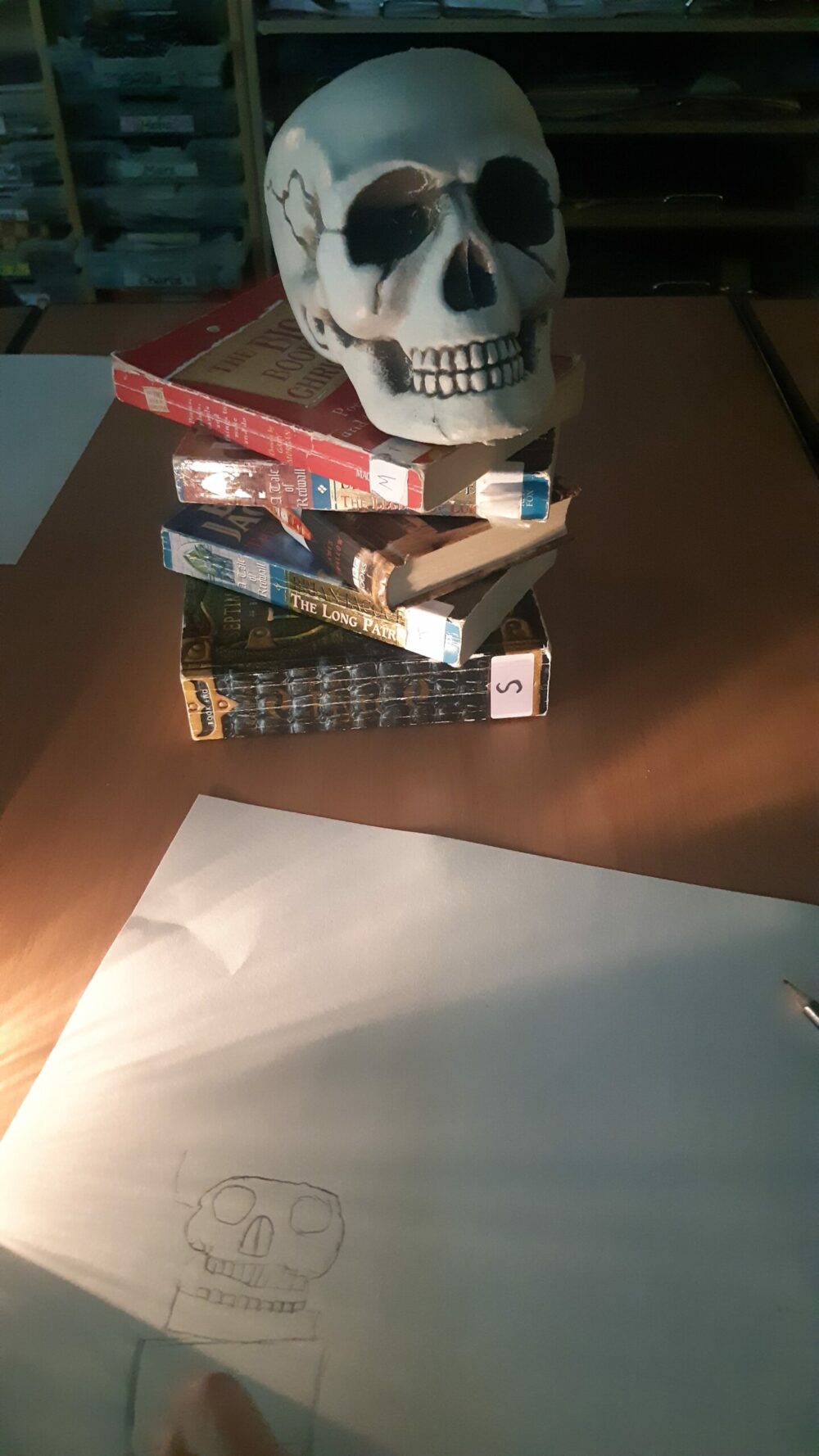
We’re going to develop the quality of your line making and use intuition to create composition.
Begin by observing the objects in front of you on the table, noticing the shapes they make and how they relate to one another.
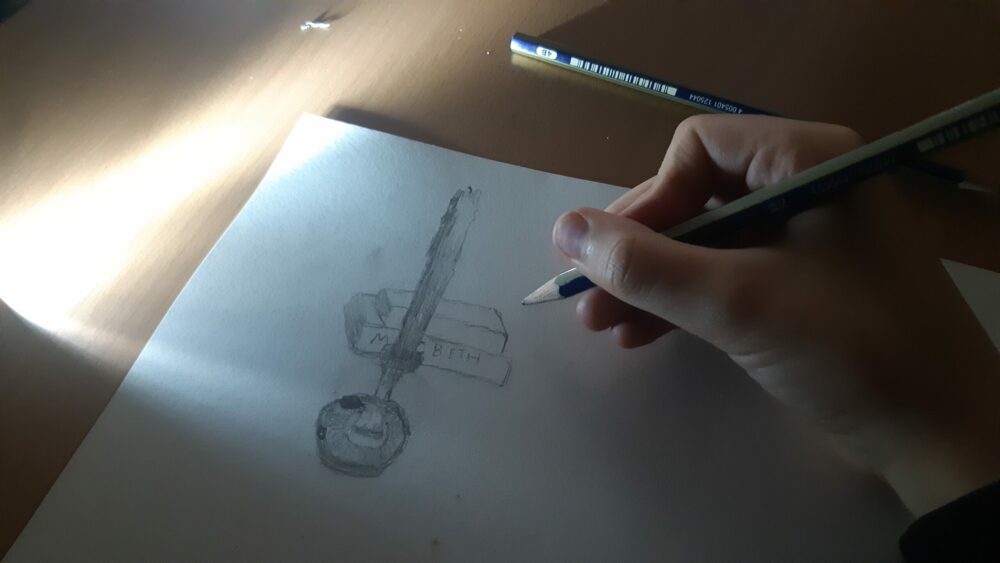
Take your charcoal or pencil and draw a thick, ribbon like line that traces the line of what you see. Perhaps a feather is placed alongside some fabric – can you follow the line of these two objects at the point of contact with the table?
If you are using candlelight – how does the flickering light change this line?
Focus primarily on the dark or the shadows – what lines can you find that follow these? Can you find other lines that connect the objects together?
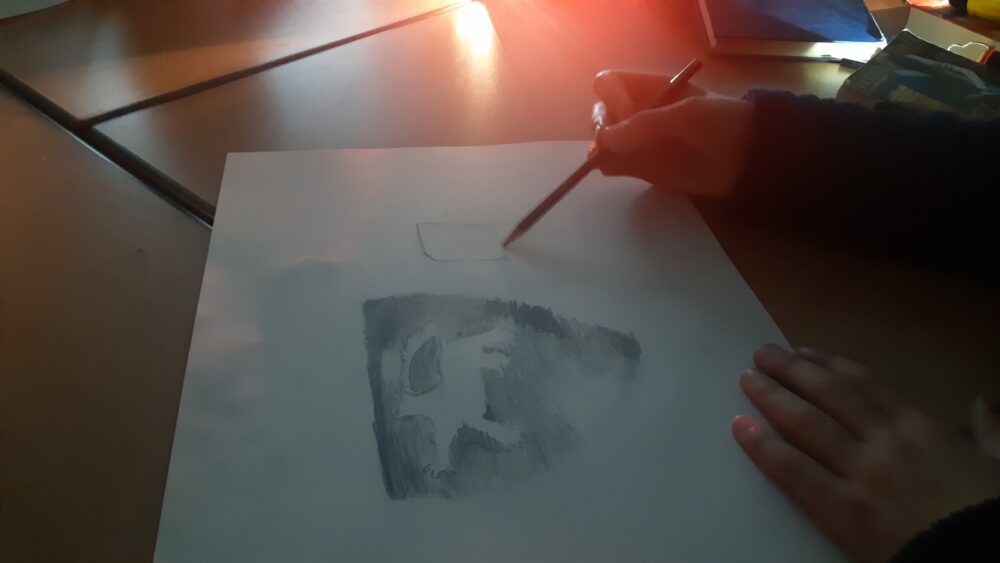
Allow the lines you’re making to flow between the objects. Work quickly, without too much thought or focus on drawing exactly what you see.
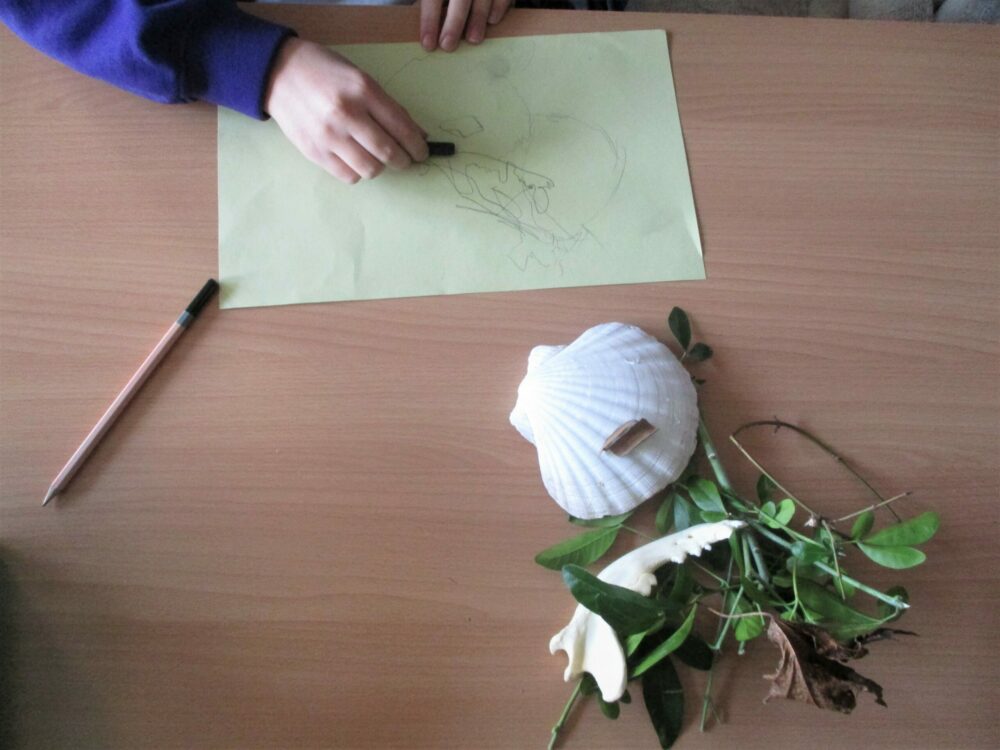
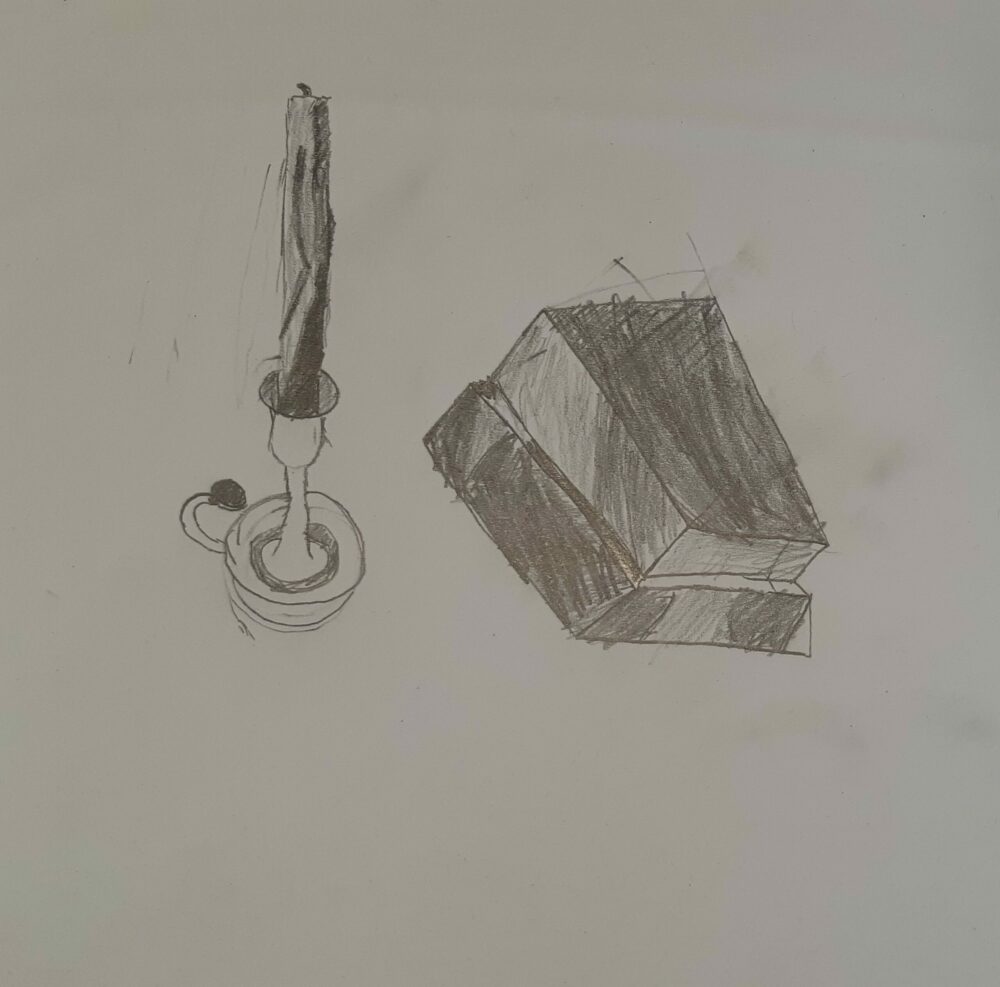
Please see the existing AccessArt resource of this activity here.
Starter Discussion:
In Act 1 Scene 4 King Duncan makes on Macbeth the new title Thane Of Cawdor as a reward for his valour in battle. In doing so, the first of the witches’ prophecies has come true. Macbeth also heard from the witches that he will later be King – but with a King already in reign, what thoughts begin to enter Macbeth’s mind?
Look at the following quote:
‘Stars hide your fires!
Let not light see my black and deep desires:
The eye wink at the hand! Yet let that be,
Which the eye fears, when it is done, to see’
(Act 1 Scene 4)
What does Macbeth mean by this?
Macbeth knows that in order to be King himself, he must kill King Duncan. However at this point, he is haunted by this thought and his speech expresses how he does not want his eye to see what his hand does. What does this tell us about his inner feelings? He is ambitious – but how does he feel about the idea of murder?
Soon after this in Act Scene 5 we meet Lady Macbeth for the first time. This scene takes place in Macbeth’s castle. Lady Macbeth reads of Macbeth’s success, and the witches’ promises via a letter. Although the letter doesn’t explicitly say that Macbeth is considering murder, Lady Macbeth quickly knows this is what they must do.
She delivers a powerful speech calling upon dark spirits to help her not feel empathy or guilt, so she is able to be part of this murderous act. She mentions several images of dark and light such as a raven, smoke of hell, milk, blood – and how she doesn’t want ‘..heaven to peep through the blanket of the dark’.
NB for teachers – optional reading out of Lady Macbeth’s ‘unsex me here’ soliloquy depending on whether you feel it’s appropriate given the age of the children.
Despite his reservations and faltering over whether to commit murder, Lady Macbeth manages to persuade Macbeth to murder King Duncan. Later, after murdering King Duncan and while plotting the murder of his friend Banquo, Macbeth speaks again of darkness casting shadow over light.
‘…Come, seeling
Scarf up the tender eye of pitiful day:
And with thy bloody and invisible hand
Cancel and tear to pieces that great bond
Which keeps me pale! – Light thickens; and the crow
Makes wing to the rooky wood:
Good things of day begin to droop and drowse;
Whiles night’s black agents to their prey do rouse..’
(Act 3 Scene 2)
Here, Macbeth means there must be no tenderness or pity if he is to succeed in his ambition to be King. What do you think this speech says about his shifting state of mind?
After the murder of King Duncan, his own sons flee the castle. In doing so, it looks like they are the guilty culprits of Duncan’s murder. Macduff, loyal servant to King Duncan, brings news of this and declares that Macbeth has been chosen as the new King. What might the impact of this second prophecy coming true have on Macbeth?
Which sounds more powerful in the play Macbeth – light or dark? Heaven or hell? Good or evil?
Can you list the imagery in this speech? Now do the same for the imagery evoked by Lady Macbeth when she speaks of not wanting ..’heaven to peep through the blanket of the dark’.
Context:
Shakespeare uses light and dark as metaphors for good and evil, usually in the form of day and night. Macbeth is a creature of the night, who brings darkness too his home and all that know him.
Many of Macbeth and Lady Macbeth’s speeches or interactions take place in hushed corners of the castle, out of ear shot. They also ‘think out loud’ quite often. How do you think this must have felt like being an audience member watching the play and ‘eavesdropping’ on these moments?
Main Activity: Light and Dark Macbeth Posters.
Look back at your warm up ‘candlelit’ drawings. Observe the areas that are in shadow and those that are highlighted.
In the warm up you did some ‘untraditional’ observational drawing related to light and dark. This time, you’re going to build on these techniques and use your imagination a bit more.
Imagine you are being asked to create a poster for Macbeth, showing the role that light and dark has in the play.
You may want to illustrate several of the images conjured by Macbeth and Lady Macbeth in their speeches (the raven, the blanket of hell, the rooky wood, bloody and invisible hand etc) or may want to focus on one in particular.
How can you draw these images? Are you going to draw a recognisable crow or will you draw a close up of a black feather that sweeps across the page in a more abstract way?
How could the thick ribbon like lines you used in the warm up be used in your illustration? In your imagination what does heaven look like and how could it peep through the blanket of hell?
Use your sketchbook to draft a design of your ideas. Drawing as we think in this way helps develop creative problem solving. Develop your ideas as you draw roughly – there’s no need to be too ‘finished’ at this point.
Think about the composition and what you want to communicate in your drawing.
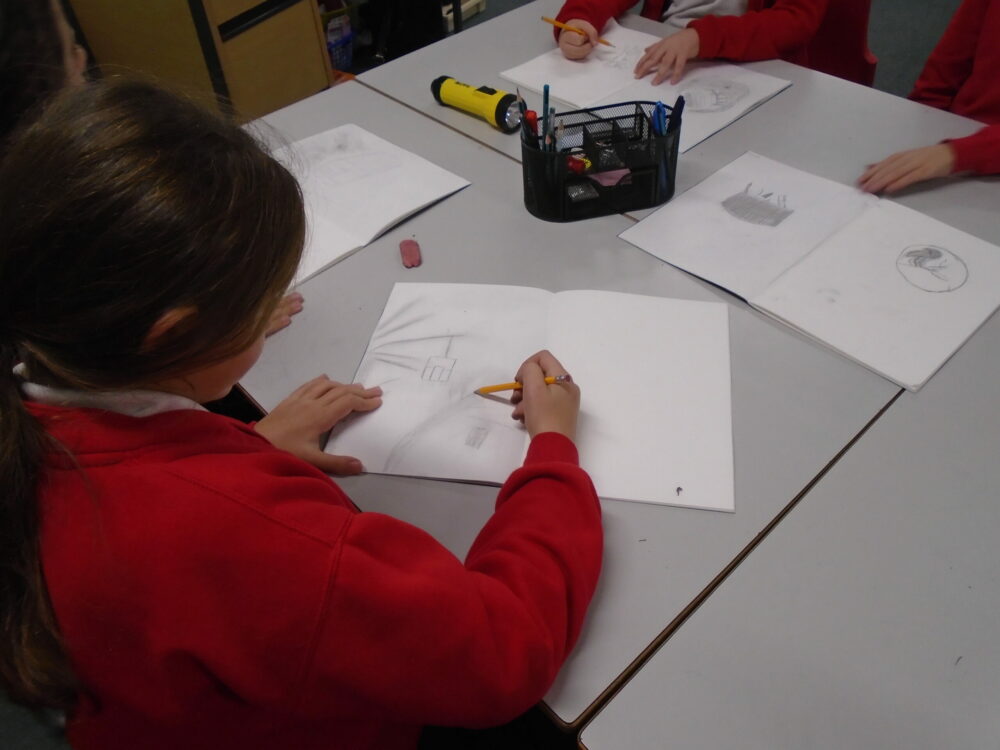
How about adding some of the words or quotes from the play? Does this help you to consolidate your ideas?
The theme we are looking at is light and dark – so charcoal and pencils will work well for this drawing – but can any colours enhance your art work too?
Once you have drafted your idea, move onto a fresh piece of paper and start drawing your final design.
Try not to rush your poster. If you don’t get time to finish it you could take it home and finish it there, or maybe there will be time at the end of another session. It may also be possible to use the whole of this session for planning and re working your design – and then another session for developing the final poster.
Reflection:
Stick your work up on the wall or hold it up.
Can you share your creative thought process with the class? How did you drawing in rough first help you refine your ideas?
Which light and dark imagery do you find most evocative or memorable? Why?
Do you think drawing in this way would make a good poster for a performance of Macbeth and want people to go and see it?
Move onto session 5 here.

